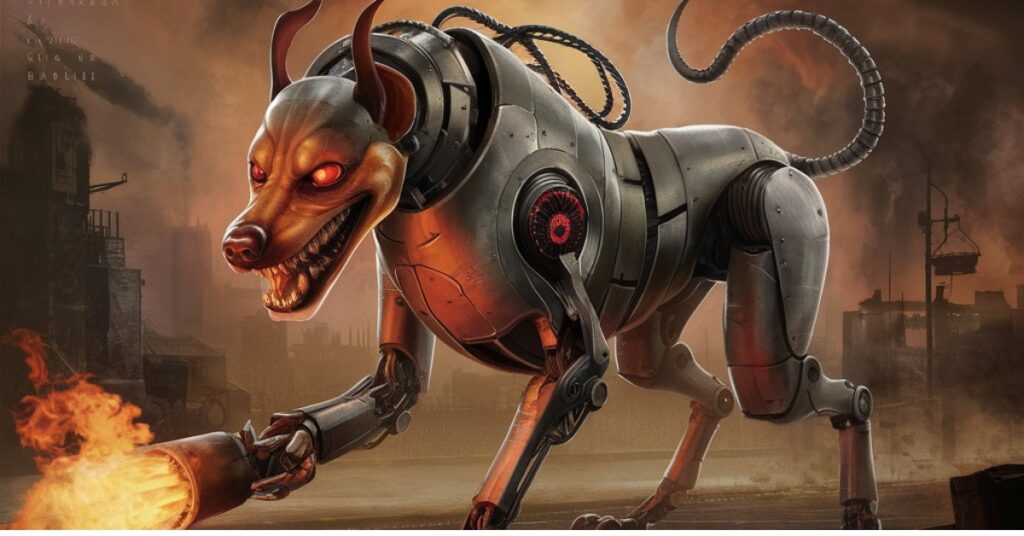Introduction: Fahrenheit 451 Mechanical Hound Hound
The Mechanical Hound, a symbol of fear and surveillance in Fahrenheit 451, represents the oppressive society depicted in Ray Bradbury’s novel. This introduction explores the mystery surrounding the creature, its significance, and its broader implications for the narrative.
It delves into its intricacies, revealing layers of symbolism and societal commentary, inviting reflection on technology, control, and individuality in our world. Join us on this journey to uncover the secrets of the Mechanical Hound.
Origins and Evolution: Tracing the Development of the Mechanical Hound
Fahrenheit 451 is a dystopian novel that delves into the origins and evolution of the Mechanical Hound. A tool initially designed for illegal book hunting. It evolves into a symbol of state control and oppression, reflecting the societal shift towards censorship and conformity.
The Mechanical Hound’s transformation into a fearsome instrument of surveillance and enforcement reflects the growing power of authoritarian regimes. The text explores the intricate interplay between technology, society, and individual freedom, prompting readers to contemplate the potential drawbacks of sacrificing liberty for security.
Anatomy and Features: A Close Examination of the Mechanical Hound
In “Fahrenheit 451,” Ray Bradbury’s Mechanical Hound is more than just a menacing presence; it’s a symbol of oppressive control. Let’s dissect its anatomy and features to unravel its significance. With its sleek metallic frame and razor-sharp claws.
the Hound embodies the cold, unyielding nature of the dystopian society it serves. Its sophisticated sensors and AI capabilities make it a formidable foe, capable of tracking down dissidents with ruthless efficiency.
Yet, beneath its mechanical exterior lies a deeper layer of symbolism, representing the dangers of unchecked technological advancement and the erosion of individual freedoms. By examining the intricacies of the Mechanical Hound, we gain insight into Bradbury’s cautionary tale and the timeless themes it explores.
Functionality and Purpose: Understanding the Role of the Mechanical Hound
The Mechanical Hound, a tool designed by Ray Bradbury, plays a crucial role in the dystopian world of “Fahrenheit 451.” It represents the government’s pursuit of conformity and control, hunting down and eliminating those who defy the oppressive regime by harboring books.
Equipped with advanced tracking mechanisms and lethal capabilities, the Hound represents the dark underbelly of technological advancement and the consequences of surrendering individual autonomy to authoritarian rule. Understanding its purpose provides insight into broader themes of censorship, surveillance, and resistance.
Symbolism and Significance: Decrypting the Meaning Behind the Mechanical Hound
The Mechanical Hound in Ray Bradbury’s “Fahrenheit 451” is a symbol of oppressive regime, unchecked power, and suppression of free thought. Its relentless pursuit of dissenters mirrors dystopian societies’ surveillance and control.
The Hound’s mechanical nature highlights the dehumanizing effects of technology used for oppression. Understanding the symbolism behind the Mechanical Hound helps readers understand themes of censorship, individuality, and resistance in Bradbury’s cautionary tale.
Society and Surveillance: The Intricate Interplay of Technology in Fahrenheit 451
“Fahrenheit 451” by Ray Bradbury explores the consequences of a society consumed by mass media and lacking critical thinking. The Mechanical Hound represents the government’s control over individual freedoms. while the relentless pursuit of dissenters highlights the pervasive surveillance culture.
Bradbury’s novel serves as a warning against the dangers of sacrificing personal autonomy for societal conformity, emphasizing the importance of safeguarding individual liberties in the face of technological advancement. The novel serves as a chilling reminder of the dangers of a surveillance-driven society.
Montag’s Encounter: Unraveling the Impact of the Mechanical Hound
In “Fahrenheit 451,” Montag’s encounter with the Mechanical Hound is a pivotal moment in his journey. The Hound’s relentless pursuit awakens Montag to the oppressive nature of society, igniting a desire for rebellion and truth.
The menacing presence of the Mechanical Hound highlights the dangers of blind obedience and the fragility of individual autonomy in a dystopian world. Montag’s confrontation with the Hound symbolizes the clash between censorship and the human desire for freedom and knowledge.
Ray Bradbury’s story highlights the transformative power of resistance and the enduring quest for truth in adversity.
Psychological Implications: Analyzing the Fear Factor of the Mechanical Hound
“Fahrenheit 451” explores the psychological implications of the Mechanical Hound. A creature that instills fear and reflects societal anxieties about surveillance and control. The Hound’s relentless pursuit of dissenters symbolizes the threat of government intrusion and personal privacy erosion.
This fear-inducing aspect serves as a tool for psychological manipulation, instilling paranoia and conformity among the populace. The Hound’s mechanical nature blurs, the line between man and machine, amplifying the existential dread of being hunted by a soulless entity.
The story prompts readers to critically examine the psychological toll of living in a society ruled by fear and surveillance.
Critiques and Interpretations: Evaluating Different Fahrenheit 451 Mechanical Hound
The Mechanical Hound in “Fahrenheit 451” has been a subject of debate among readers and scholars. Some see it as a symbol of oppressive state control. while others see it as a reflection of society’s increasing reliance on automation.
The Hound’s role in the narrative is also a subject of interpretation. With some viewing it as a metaphor for censorship and others as a manifestation of characters’ fears. This interpretation provides insight into Bradbury’s dystopian world and its complex themes.
Conclusion: Reflecting on the Legacy of Fahrenheit 451 Mechanical Hound
The Mechanical Hound in “Fahrenheit 451” is a symbol of societal control, technological advancement, and human psyche. It serves as a reminder of the dangers of censorship, surveillance, and erosion of individual freedom.
The enigmatic presence of the Mechanical Hound captivates audiences and challenges them to resist oppressive regimes. Its legacy reminds us of the importance of preserving intellectual freedom in an ever-changing world and the need to remain vigilant in safeguarding our liberties.
The Mechanical Hound’s significance extends beyond Bradbury’s novel, urging readers to resist stifling free thought and expression.

